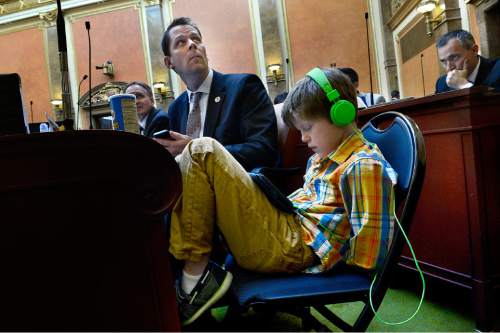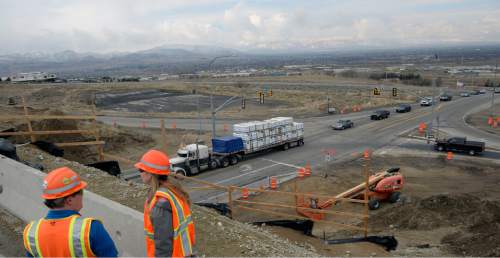This is an archived article that was published on sltrib.com in 2015, and information in the article may be outdated. It is provided only for personal research purposes and may not be reprinted.
Lehi and its high-tech firms want to jump to the front of the line for transportation projects, arguing the state is reneging on promised work used to lure companies there.
They warn that Utah will lose many new, big employers without improvements.
At issue: a $450 million upgrade to the Interstate 15 corridor through Lehi, including rebuilding a congested interchange with State Road 92 at Thanksgiving Point and adding a "flyover" bridge nearby to improve access across the freeway.
The Utah Transportation Commission, which prioritizes highway projects statewide, currently has that work slated to occur in about five years.
Lehi, developers and their local legislators are urging state lawmakers to start the project next year instead — and borrow the money via bonding if necessary. Otherwise, they say, some major high-tech companies won't come to its "silicon slopes," while congestion forces others to delay expansion.
"We don't want 'silicon slopes' to become 'silicon slow,' " Nathan Ricks, managing partner of Thanksgiving Park Development, told the Legislature's Transportation Interim Committee.
That committee — co-chaired by Sen. Al Jackson, R-Highland — heard arguments this week that the state made and broke promises to improve transportation to attract big companies such as Adobe. State officials deny that.
—
Promises, promises? • As an example, Rep. Jacob Anderegg, R-Lehi, said, "Part of the incentive package that was put together for Adobe included the commitment that the TRAX lines would be completed to their front door sometime around 2018."
The Utah Transit Authority has plans to extend light rail to Adobe someday, but not that soon. Anderegg said Utah economic officials similarly pledged to upgrade the freeway sooner than is now planned.
He said Adobe officials "put off the second phase of their construction, bringing an additional 800 to 1,400 jobs to Utah because of the perception of a failure" to keep promises.
Anderegg and Lehi Mayor Bert Wilson said they know of two Fortune 50 companies that looked at coming to Lehi, but are now stepping back.
"It is quite literally because they have had discussions with Adobe," Anderegg said, "and they have had conversations with a few others" who say transportation commitments were broken.
The state believes it broke no such vows, said Theresa Foxley, managing director for corporate recruitment for the Governor's Office of Economic Development.
"The incentive package that we put together included only the tools over which we have control," she said, such as tax credits, not transportation projects.
While Adobe came before she or GOED Executive Director Val Hale had their current jobs, Foxley said, "We went through our files, and that's what we were able to find."
But "promises were made to businesses that we would take care of this" congestion, Wilson said. "If we don't come through with the promises we've made to people, I'm afraid we're going to turn the direction the other way" and hurt job growth.
—
Business is booming • Regardless of any assurances, developers and others say rapid growth in Lehi makes quick highway work there imperative.
For example, Jackson asked Foxley where economic development in the state could be put most at risk for lack of better transportation — and she pointed to Lehi.
"Lehi has as much growth right now as we have in all of Salt Lake County," she said. It has 1.5 million square feet of commercial space under construction with 11 new buildings, compared with 1.4 million square feet of similar construction underway in all of Salt Lake County.
Ricks, with Thanksgiving Development, said that in the past eight years, 180 acres around I-15 in Lehi were newly developed with 600,000 square feet of retail, 1.7 million square feet of office space, 900 multifamily units, a hospital and four hotels.
Before the Legislature meets in January, he said, another 42 acres are expected to be developed there with 40,000 square feet of retail, 850,000 square feet of office space and a hotel — adding 4,000 new jobs.
He said overall development could more than double there in the next decade.
"It's a lot more congestion," he said. "How do we get this under construction now, like in 2016. We can't wait for 2020."
Added Wilson: "If we go five years from now, we're going to be in a mess we can't get out of."
—
Is it affordable? • Jackson brought in state Treasurer Richard Ellis, and asked him if Utah could afford to borrow via bonding for more such transportation projects.
Ellis said it could, while staying well within legal limits, but noted lawmakers should also look at other potential needs such as building a new prison or new water projects.
"Can we actually fund it [the Lehi work]?" Anderegg asked. "To a large extent, we can — if we have the political will to do so."
But vaulting Lehi to the head of the line could prove unpopular with lawmakers elsewhere.
For example, in a speech Thursday at completion of a new interchange on Bangerter Highway, Sen. Howard Stephenson, R-Draper, talked about the "bad old days" when transportation committee members first funded projects in their own areas. He praised using the independent Transportation Commission instead to set priorities scientifically.
That has brought "prioritization based on need, based on traffic congestion, based on accident frequencies," he said. "We also have a Transportation Commission that is ensuring UDOT [the Utah Department of Transportation] is doing things according to science and not politics."





